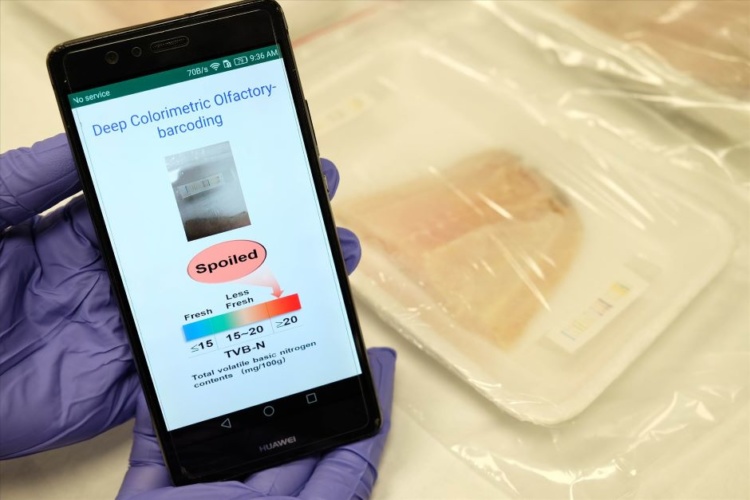The ‘electric nose’ (e-nose) comprises a ‘barcode’ that reacts with gases produced by decaying meat, and a ‘barcode reader’ that uses AI to interpret the combination of colours on the barcode, researchers confirmed. By integrating it into a smartphone app, which the team claim can yield results in 30 seconds, the e-nose is portable and predicts meat freshness with 98.5 per cent accuracy.
PEGS sensors aim to cut food waste
Described in a paper published in Advanced Materials, the e-nose aims to reduce food waste and has been tested on commercially packaged chicken, fish, and beef meat samples left to age.
“These barcodes help consumers to save money by ensuring they do not discard products that are still fit for consumption, which also helps the environment. The biodegradable and non-toxic nature of the barcodes also means they could be safely applied in all parts of the food supply chain to ensure food freshness,” said co-lead author Professor Chen Xiaodong, director of the Innovative Centre for Flexible Devices at NTU.
The team said they have now filed a patent for this method and are working with a Singapore agribusiness company to extend the concept to other types of perishables.
Barcodes in the e-nose have been designed to mimic receptors in the mammalian nose. When gases produced by decaying meat bind to receptors in the mammalian nose, signals are generated and transmitted to the brain. The brain then collects these responses and organises them into patterns, allowing the mammal to identify the odour present as meat ages and rots.

Each bar in the e-nose acts as a receptor and is made of chitosan embedded on a cellulose derivative and loaded with a different type of dye. The dyes then react with the gases emitted by decaying meats, scientists explained, changing colour in response to the different types and concentration of gas resulting in a ‘scent fingerprint’ for the state of any meat.
For the study, scientists developed a classification system (fresh, less fresh or spoiled) using an international standard that determines meat freshness. This is done by extracting and measuring the amount of ammonia and bioamines found in fish packages wrapped in transparent polyvinyl chloride (PVC) and stored at 4°C (39°Fahrenheit) over five days at different intervals. They then used barcodes glued on the inner side of the PVC film without touching the fish to monitor freshness.
According to researchers, a type of AI algorithm known as ‘deep convolutional neural networks’ was trained with images of different barcodes to identify patterns in the scent fingerprint. To gauge the prediction accuracy of their e-nose, they monitored the freshness of commercially packed meat with barcodes glued on the packaging film, and stored at 25°C (77°Fahrenheit). Over 4,000 images of the barcodes from six meat packages were taken at different time intervals over 48 hours without opening the different meat packages.
Results revealed 100 per cent accuracy in identifying spoiled meat, and a 96 to 99 per cent accuracy for fresh and less fresh meats, according to the team’s research paper. In comparison, the research team said they randomly selected 20 barcode images from each category to assess the accuracy of Euclidean distance analysis, a commonly used method to measure the response of sensors like the barcode used in their e-nose. This analysis showed a 61.7 per cent overall accuracy, they confirmed.
Professor Chen said that the team are working towards providing a ‘broadly applicable new platform for food quality control’, commenting: “While e-noses have been extensively researched, there are still bottlenecks to their commercialisation due to current prototypes’ issues with accurately detecting and identifying the odour. We need a system that has both a robust sensor set-up and a data analysis method that can accurately predict scent fingerprints, which is what our e-nose offers.”




Swiss geoengineering start-up targets methane removal
No mention whatsoever about the effect of increased methane levels/iron chloride in the ocean on the pH and chemical properties of the ocean - are we...